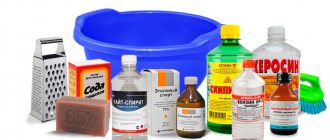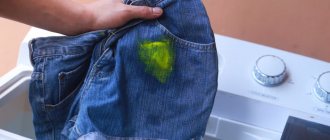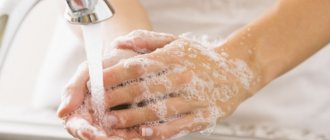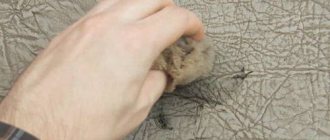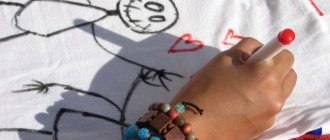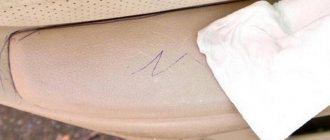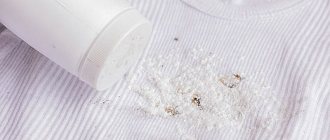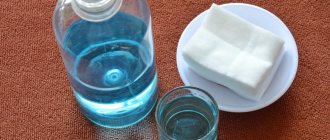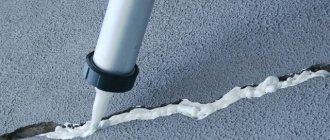Paint that gets on fabric is a complex type of contamination that can be difficult to deal with at home.
However, if you take action in time and use the right tools, you can return things to their original appearance.
Housewives get rid of stains using vinegar, kefir, ammonia and even butter. If results cannot be achieved, then they resort to household chemicals.
Let's take a closer look at how to remove dried paint from clothes at home.
Things to consider
- If the item is expensive and you are afraid to take risks, it is better to immediately take it to the dry cleaner.
- If you want to clean the dirt yourself, don’t delay it. Try to scrub off the paint within the next few hours after the stain appears.
- If the paint has had time to dry thoroughly, first very carefully scrape off the top layer with a blade. This will make it easier to wash it off. But if the fabric is quite delicate, it is better not to use a blade, otherwise you may accidentally tear it.
- All the methods below are working. They have been tested by real people who have shared their experiences on various forums. But very often it is not clear what kind of paint left the mark. Therefore, if the product does not help, perhaps it is simply not suitable for the substance in which your item is stained.
- If the stain is large, you can try several products on it at once in different areas. This way you will know which method will definitely help you. If the stain is small and the chosen product cannot cope with it, just try another one, lightly rinsing off the previous one with water.
- Also test the selected product first on an inconspicuous area of clothing. This will ensure that the color of the fabric is not affected.
- You can rub the product into a rough cloth with any brush or the back of a dishwashing sponge. For delicate stains, it is better to rub it with your hands or clean the stain with the fabric itself, as when washing.
Can I remove it myself?
You can remove paint stains from clothes if you do it correctly.
The complexity of the work is due to a number of factors, including:
Duration of stay of the stain on clothing. The faster measures are taken to remove it, the easier it is to deal with the stain.- Type of dye. The hardest thing is to get rid of persistent compounds (hair and eyelash dye, construction paints). Art and food dyes are easier to remove.
- Degree of pollution. The larger the stain, the more difficult the work to remove it.
The type of matter matters. Paint penetrates faster and deeper into fibrous fabrics than into a smooth surface. The task becomes more difficult if the stain was applied to delicate fabrics.
When can you handle it yourself, and when should you turn to professionals for help?
Before you begin processing, you need to pay attention to the following points:
- It is almost impossible to get rid of construction paints (water-based, acrylic, oil) on your own. Sometimes it is not possible to remove them even in professional dry cleaners.
- The best stains to remove are from thick fabrics, such as jeans.
- You can deal with the stain yourself if no more than 2-3 days have passed since the paint got on your clothes. Later, it will be difficult to remove it at home.
If even the professionals couldn’t get rid of the paint, but you want to preserve the item, you can use decorative techniques. Stains are masked with rhinestones, stickers, stripes and other elements.
Acetone
Another potent clothing dye remover that is only suitable for tough fabrics. In addition, it is not advisable to use it for colored materials, since the shade may change after cleaning. You can take classic acetone or nail polish remover. Soak a cotton pad or a piece of cotton wool in the selected composition and gently wipe the contaminated areas on the damaged item. Move strictly from the edges of the stain to its middle. After this treatment, the outfit should be washed in the usual way (by hand or in a machine).
HOW TO REMOVE PAINT STAINS FROM CLOTHES. HOW TO REMOVE PAINT STAINS FROM CLOTHES.
If at least once in your life you have had the opportunity to sit comfortably on a freshly painted bench in the park and, against the backdrop of birdsong, suddenly realize with horror that behind you is now striped and, most likely, green, then this article is for you. Or if you are doing renovations right now and accidentally drip paint on yourself, then don’t pass by either. And if you are a happy mother of a child who has mastered finger paints perfectly, and then mastered a sofa, a cat and a Persian carpet, then you definitely need to read this article to the very end.
Right now you will learn the 11 most effective ways to get rid of paint stains!
Method one - turpentine, kerosene or acetone
As you correctly guessed from the name, you will need turpentine, kerosene, acetone and ammonia (you can buy it at any pharmacy). To remove a paint stain, first moisten it with turpentine, kerosene or acetone, and then rub it with a cotton pad soaked in ammonia until the stain completely disappears.
Important!
Before removing a stain, make it a rule to check on an inconspicuous area of the fabric how all these liquids act on it. It will not be very pleasant if it suddenly fades or some other irreversible changes occur to it.
Method two - for old stains
Turpentine and ordinary baking soda, which you can easily find in any grocery store, will help remove old paint stains. Moisten the paint stain with turpentine, and then clean it with a soda solution and rinse in warm water. This is how you can easily and effectively remove an old paint stain, try it!
Method three - water-based paint
A vinegar solution works great for stains from water-based paint.
Recipe:
Mix vinegar and water in equal proportions.
To remove a stain, take a cotton pad or cloth, soak it in the resulting solution and rub the stained area. The stain should disappear right before your eyes.
Method four - latex and acrylic paint
You'll have to work hard here. To remove stains from these types of paints, you will need an arsenal of different tools and tools: a toothbrush, stain remover (or bleach), laundry detergent and water.
Step 1.
First, turn the clothes inside out and wet them generously with cold water, then wring them out and machine wash them on the longest program at 30 degrees.
Step 2.
If the stain does not disappear, repeat the procedure a second time.
Step 3.
If this time the stain remains in place, then sprinkle it with tooth powder and try to remove it with a toothbrush in a circular motion (for these purposes, of course, it is better to take an old brush that no one needs). Rinse off the remaining powder with hot water and wash the item again, this time at the highest possible temperature (check the tag).
Step 4.
If all this does not help, then feel free to move on to the big guns - stain remover or bleach.
Method five - alkyd enamel
The main enemy of alkyd enamel stains is white spirit, which can be purchased at any hardware store. Turn the item inside out, soak a cotton swab in white spirit and treat the stain. If the fabric is very delicate and capricious, then be sure to place paper towels or white napkins before processing to reduce the aggressiveness of the product. Then put the item in the wash or wash it by hand using laundry soap. The washing step is mandatory here, because you are unlikely to like the scent of white spirit.
Method six - oil paint
Oil paint stains take first place in the list of the most unpleasant and difficult to remove. Therefore, if you do sit on a painted bench, but the item is dear to you and the newly acquired stripes do not paint it at all, then it is better to go to a dry cleaner, where professionals will take care of the stains.
Important!
Everything depends on the speed of reaction. Dry cleaning can only help you for 3-5 days, while the stain is fresh. If you didn’t have time, then most likely you will have to throw the item away or put up with the stripes.
But while the stain is fresh, before you run to the dry cleaner, try the old time-tested method. Pour liquid soap generously directly onto the stain, wait until it is absorbed, then take a cloth and try to gently wipe it off, then rinse in cold water.
The whole truth about turpentine and oil paint stains
If you treat the stain with a sponge dipped in turpentine, the paint itself will disappear, but, alas, it will leave a greasy stain
.
Method seven – for wool, synthetics and cashmere
All the methods listed above are very effective, but are completely unsuitable for fabrics such as wool, synthetics and cashmere. Powerful solvents are certain death for them; the fabric itself can disappear along with the stain. Therefore, a more delicate approach is required here. Soak a cotton swab in any vegetable oil and remove the stain in a circular motion. As the tampon becomes dirty, it must be changed. After all manipulations, wash and dry the item as usual. Most likely the stain will disappear.
Method eight - acetone
You don't have to buy acetone to remove paint stains. Classic nail polish remover is perfect, as it contains it in abundance, and you probably have the liquid itself at home. Soak a cotton swab in it and treat the stain until it disappears. Then wash the item as usual.
Important!
Acetone, like any other solvent, is a very aggressive substance. Therefore, before removing a stain, check the effect of acetone on an inconspicuous area of the fabric, so that the situation does not arise that there is no stain and no color of the fabric.
Method nine - stain removers
Antipyatin soap is a real hit among stain removers. If the paint stain is not strong and fresh, then it will completely help to cope with it. But be careful, check that the soap does not corrode the paint of the fabric itself.
There are also a huge number of different special stain removers that you can easily find in any hardware department. For example, there are many good reviews about Amway stain remover. If the stain remover does not work immediately, try leaving it overnight and only washing the item in the morning. And this procedure must be repeated until the bitter end. Very often, stains are not removed the first time, but after a couple of attempts they disappear without a trace, so never despair right away.
Method ten - hot
It happens that regular washing works well with paint stains, but at fairly high temperatures - at least 60 degrees. But before you try this method, be sure to check the label on the clothing to find out if it can be washed at such a high temperature.
Method eleven - watercolor and gouache
If there is a gouache stain on your clothes, then it is important not to wait until the paint has completely dried, but, as soon as you see the stain, remove it immediately, then apply a dry stain remover to it and wet it with cold water. After all these manipulations, add washing powder and wash the item as usual.
A watercolor stain just needs to be rinsed under running cold water or soaked in powder and then simply washed.
We are sure that now you are a real expert when it comes to removing paint stains from clothes. But, nevertheless, it is better not to sit on painted benches, no matter how invitingly they sparkle with fresh green paint and no matter how peacefully the birds sing.
Adviсe
Recommendations for removing dried paint:
Paint-stained items should be washed separately from other clothes.- To increase washing efficiency, the fabric needs to be soaked.
- When working with aggressive agents, gloves should be used.
- You need to wash the stain as quickly as possible, even if it has already dried.
- To get rid of gouache and watercolor paints, regular washing using a simple powder is enough.
If paint is removed from fabric with cotton wool, it should be changed as often as possible so as not to smear the pigment onto clean fibers.
Acrylic or latex paint
You can remove acrylic paint from things in this order:
- Wash the fresh stain with water at a temperature of 30-35C. Wring out the item and turn it inside out.
- Rub powder or liquid detergent into the stain from the inside out and leave to act for 1 hour.
- Wash the treated clothing in a machine at a high temperature allowed for this type of fabric.
An additional way to remove acrylic paint from delicate fabrics: rub the stain with 72% laundry soap. After 20 minutes, treat with industrial alcohol. After this, the clothes can be washed in warm water.
Alcohol will help remove latex paint from clothes. It is applied to stains undiluted. It is important to note that brightly colored items may fade a little. Another option: moisten the marks with alcohol and cover with fine table salt for 30-40 minutes.
Dried latex paint can be removed mechanically. For this you need tape. A piece of adhesive tape is pressed tightly onto the contaminated areas and sharply torn off. After such a procedure, sticky traces may remain, but they can be easily removed with regular washing with powder.
Remember 4 rules
How to remove paint stains from clothes? You need to know four basic rules that will help you cope with the task.
- The fight cannot be delayed. Got paint on your pants? Don't put them away, hoping that someday you'll get around to cleaning them. The sooner you notice traces of paint, the higher the likelihood that the item will be saved. Always inspect clothes after a walk in the park, check your baby’s things after drawing.
- Determining the type of paint is half the battle. It is important to know what kind of paint the clothes were stained with. This will help you choose a product that will effectively and quickly remove the “blot”.
- We save, but do not spoil. Before using traditional methods, you need to check the composition of the fabric. There are not many universal solvents at hand. The product must be selected taking into account the characteristics of the material. This is the only way to clean the item without ruining the fabric.
- A test drive is required. Any solvent must be tested first. It is applied to the seam from the wrong side. This simple method allows you to find out how a material reacts to a particular substance. This reduces the risk of hopelessly damaging the item.
The smaller the area of contamination, the higher the chances of returning the item to the wardrobe. Huge stains (especially if they are already old) are almost impossible to remove at home. If you see a large paint stain, take your clothes to the dry cleaner. That's where you want to go with designer items. Experiments on expensive clothes are unacceptable - the risks of completely ruining the outfit are too high.
Features of water-based paint
Water-based paint is valued by builders for such characteristics as the absence of a strong odor, ease of application to the surface, and high drying speed. Surfaces painted with color after drying acquire a glossy sheen or matte texture, depending on the composition.
Paint is used not only for repairs, but also for creativity. Artists use it to paint pictures; parents buy this paint for their children to paint. This is one of the paints that can be washed off relatively easily from any surface if you do not wait for the stains to dry.
On the left is a soap solution for soaking soiled clothes, on the right is ethyl alcohol for local removal of stains from water-based emulsion.
Additional recommendations
In kindergartens and schools, drawing lessons mainly use watercolor or gouache paints. And even if a child wears an apron, arm ruffles or even a robe, stains on the clothes still cannot be avoided. If there are stains of adhesive-based paint on a blouse or pants, or on a school uniform made of fine wool, the following recipe will help:
- mix a tablespoon of ammonia alcohol and oxalic essence;
- Dissolve the resulting mixture in a glass of water;
- gently treat stains, then immediately wash items with washing powder.
If the fabric is thick, you can add a mixture of ammonia and oxalic acid to a basin of water and soak the soiled items in it until the morning.
If there are stains left on the textiles from acrylic paint, then you will have to use a more caustic composition. To prepare it, you need to combine ammonia, table white vinegar and table salt in equal parts.
Source of the article: https://mamaclean.ru/chem-otmyt-vodoemulsionnuyu-krasku-s-odezhdy
How to remove water-based paint from clothes at home, How to wash water-based paint from things.
Traditional methods
In some cases, it is not necessary to immediately use aggressive chemicals - you can solve the problem using folk recipes.
Gasoline and alcohol
Gasoline is good for removing stains from oil paints. You need to apply it to a cotton swab and rub the stain all around. After the procedure, the item is washed using powder or gel.
Attention! It is necessary to purchase only refined gasoline, which is sold in hardware stores. A regular product may stain clothing due to impurities in the composition.
Another effective remedy is a combination of laundry soap and alcohol. This recipe can be used against difficult stains on silk and satin. First, the blot is rubbed with soap, then the fabric is rinsed, and the contaminated area is treated with alcohol. Before this, the liquid must be heated in a water bath. After cleaning, you must hand wash the item in hot water.
Alcohol and salt help remove paint from both linen and nylon fabric. The blot needs to be rubbed with heated alcohol on the reverse side, then prepared with a saline solution and washed off any remaining dirt.
Hair fixation spray
Many hair styling products contain weak solvents. They do not harm human health, but help remove stains. Just spray the varnish and throw the item in the wash.
Salt and vinegar
To clean clothes from acrylic dye, you need to prepare a solution from the following ingredients:
- salt – 1 tbsp. l.;
- ammonia - 2 tbsp. l.;
- vinegar - 2 tbsp. l.;
- water – 750 ml.
The components need to be mixed and poured into the blot, leaving the product in the basin overnight. It is recommended to cover it so that the smell of ammonia does not spread to other rooms. The procedure is repeated until the dye completely disappears.
Acetone
Instead of acetone, nail liquid is suitable. First you need to soak a cotton swab in the solution, then start rubbing the stain from the edge to the middle. At the end of the procedure, the item is thrown into the machine.
Attention! Acetone is not used on delicate fabrics.
Turpentine
This product is suitable for removing stains from delicate materials such as silk, satin and wool.
First, apply a little turpentine to a cotton swab to treat the blot on the front and back of the fabric. After 10 minutes, cover the stain with paper towels on both sides and press together with your palms. There will be traces of paint on the paper that were removed by the product.
After this, the dirt is wiped off again with turpentine and left for 60 minutes, then the clothes are washed in the usual way in a machine or by hand.
Butter
Housewives recommend using this product to remove oil-based paint from clothes, such as jeans. First remove the butter from the refrigerator: it should reach room temperature. Cut 75 g of product, combine it with 80 g of hand wash detergent. You should end up with a paste that you use to treat the contaminated area. If the stain is old, you can scrub it with a toothbrush. Remove excess composition with a paper napkin, and then repeat the procedure and cover the item with cling film. After half an hour, wash the clothes by hand, then, if necessary, repeat the wash in the machine.
Influence of fabric type
Before deciding how to remove a stain from a suit, curtains or bed linen, you need to determine the type of material.
For each type of textile, you need to use chemicals and improvised means that, when processed, will not disturb the structure of the fibers, will not “burn” holes or spoil the design:
- Turpentine is suitable for processing different types of fabric - thick and thin, natural and artificial, plain and multi-colored.
- Cotton, linen and wool will not be harmed by vinegar and baking soda.
- Ammonia combined with high temperature will destroy the wool fibers.
- Natural silk will be damaged by soda, caustic alkalis and strong mineral acids.
- Artificial silk is destroyed by strong alkaline compounds, undiluted mineral and organic acids, acetone, and high temperatures (above +40°C).
When deciding how to remove paint from jeans, a down jacket or a tracksuit, you should first try less aggressive means. Powerful solvents should be used when safe drugs have proven to be ineffective.
Removing other stains
It is not uncommon to need to clean other types of paint. It is worth considering separately for children: gouache and watercolor. They are water-based, so fresh stains can be removed with regular washing. Large stains may not be washed off completely, leaving their mark on the entire surface of the clothing. Such contaminants are first washed by hand under waste water, after which they are also sent to the washing machine.
Enamel products are susceptible to solvents. Soak a cotton pad in it, squeeze out the excess and start wiping off the dye. As the color changes to the cotton wool, replace it with a new one.
The easiest way to deal with stains on leather products. Very fresh marks can be wiped off with regular wet wipes. More complex ones with vegetable oil or laundry soap. Rub the selected product onto the stain, wipe with a dry soft cloth and remove any residue with a damp, clean cloth.
Delicate fabrics require a unique approach. Heat ammonia to a temperature of 40-50 degrees, lightly moisten a cotton swab and wipe gently. Replace the tampon as needed and continue cleaning until completely clean. Finally, pour warm water into the basin, add enough salt to form a weak saline solution. Rinse the item in it.
If it is difficult to determine the type of paint, use a universal laundry soap. Rub the contaminated surface thoroughly and leave for 1-2 hours. Wipe with cotton and rinse.
Enamel and oil paint
You can remove oil paint or enamel if you first wipe it with vegetable oil. Sunflower, olive or any cosmetic oil will do. After treatment, the item must be washed with liquid dish soap and then with powder. It is guaranteed to remove any remaining fat.
Second method: take 72% laundry soap and alcohol, ethyl or technical. First, things need to be washed in water at 38-40 ° C with soap and soaked for 30 minutes. Wipe off any remaining traces with alcohol.
Advice! It is quite easy to remove paint from a Bolognese jacket with white alcohol; kerosene will also work.
Several ways to scrub off enamel:
- Apply gasoline, then go through an ammonia solution, wash the item with powder and rinse thoroughly.
- Prepare a mixture of gasoline and acetone in equal proportions and, moistening a cotton swab with it, wipe off the stain.
- If the enamel has already dried, you need to prepare the following remedy: combine turpentine, gasoline and alcohol. Distribute over stains and leave for 30 minutes. When the enamel softens, scrape it off with a knife and use the same mixture to wipe away any remaining marks.
If there are faint stains on clothes, a soda solution will remove them. For 200 ml of water you need to take 2 tbsp. l. soda Soak the desired area in the prepared product for several hours.
How to remove ink from a printer
Having a printer at home, sooner or later paint contamination from it occurs. This could be during refills, home repairs, or the device simply malfunctioned and released too much ink onto the paper. In any case, action must be taken urgently. It is advisable to immediately soak in cold water, or better yet, wash in it. Ideally, hand wash in cold water using laundry soap. To remove old paint, treat with hydrogen peroxide for 10 minutes before washing.
Kefir and borax
Borax is a sodium salt of boric acid, which is used in everyday life to remove stubborn contaminants. It can be purchased at any hardware supermarket or pharmacy; the product is inexpensive. Sodium tetraborate not only removes old paint, but also removes stubborn stains from alcoholic and coffee drinks, felt-tip pens, and removes rust.
To prepare an effective composition, take 55 g of borax, 30 g of table vinegar, 75 g of natural kefir with a fat content of 3.2%. Mix all the ingredients so that the product is homogeneous. Apply the solution to the stain and let the mixture dry slightly. Then put cling film over the composition and turn the item inside out. It also needs to be treated with a similar solution. After half an hour, evaluate the result. If necessary, increase the proportion of borax to 75 g.
Removing different types of paint
Water based paint
First question: how to remove paint from clothes? Watercolor is usually watercolor, as it is much safer for the child. They are very quick and easy to remove, especially with the help of liquid. So start with "rinsing". To do this, bring the item with the back side to running water. If a small amount of color remains, treat the stain by applying liquid detergent and gently rubbing it into the fabric before throwing it in the washing machine.
Oil based paint
If you're painting doors, walkways, or baseboards in your home, you may be working with oil-based paint, which gives a wonderful glossy look. It is more difficult to remove because it does not mix well with water. How to remove paint from clothes? Thinner is fine if it's on easy-care fabrics, but for more delicate materials it's best to stay away from harsh chemicals.
Treat the stain with dishwashing detergent before washing. Soap is designed to remove grease, so oil paints are perfect!
Acrylic
Conventional methods do not help get rid of dried acrylic paint stains. You can use an alcohol-based cleaner. Acetone and even hairspray will also work well.
Enamel
It can be removed by wiping the area with liquid dishwashing detergent. Wait a few minutes and then wash off. If the stain is stubborn, spray it with oven cleaner, let sit for about 30 minutes, and then scrub. Test the method on an unseen area of clothing first to ensure colorfastness.


